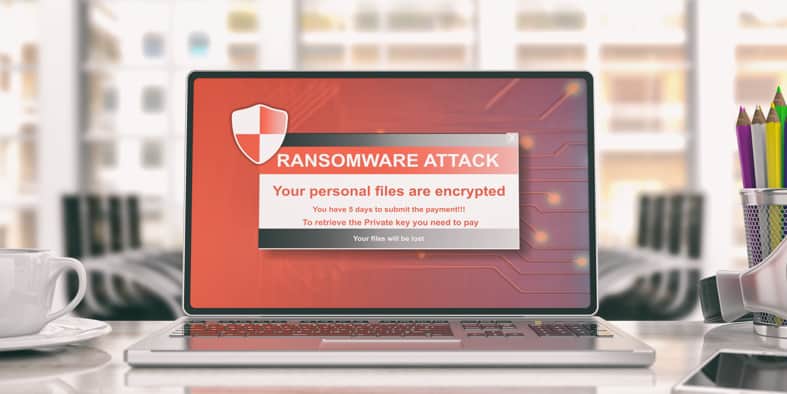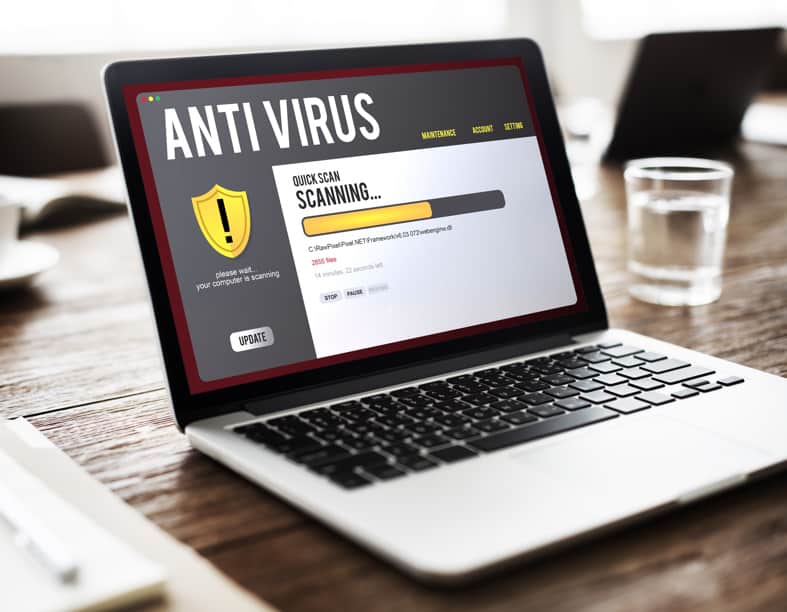
Table of Contents
What Is Ransomware?
Ransomware is a type of malicious software that encrypts files on a computer or network, rendering them inaccessible until a ransom is paid. This form of cyber attack can have devastating consequences for small businesses, as it can lead to data loss, financial loss, and reputational damage.
Why Is Ransomware Prevention and Recovery Important for Small Businesses?
Ransomware prevention and recovery are crucial for small businesses due to several significant reasons:
Protecting Critical Data
Businesses often store sensitive and critical data, including customer information, financial records, and proprietary data. Ransomware attacks can encrypt this data, rendering it inaccessible. Prevention measures help safeguard against such attacks, while recovery strategies ensure the timely restoration of vital information.

Financial Impact Mitigation
Ransomware attacks can result in substantial financial losses, not only from potential ransom payments but also due to operational downtime, recovery costs, and potential reputational damage. By investing in robust prevention strategies, businesses can minimize the likelihood of falling victim to ransomware, reducing the financial impact on their operations.
Preserving Business Continuity
Operational disruptions caused by ransomware attacks can have a cascading effect on business continuity. Prevention measures, such as regular data backups and system updates, coupled with effective recovery plans, contribute to a quicker restoration of services. This helps businesses maintain continuity and minimize the impact on day-to-day operations.
Maintaining Customer Trust
Customer trust is paramount in business, and a ransomware attack can erode that trust if sensitive customer data is compromised. Demonstrating a commitment to cybersecurity through prevention measures and swift recovery efforts reassures customers that their information is being handled responsibly and helps preserve the integrity of the business.
Legal and Regulatory Compliance
Many industries are subject to strict data protection regulations and compliance requirements. Falling victim to a ransomware attack can lead to legal consequences if the business fails to adequately protect customer data. Proactive prevention measures not only help meet regulatory requirements but also contribute to a more secure and resilient business environment.
Ransomware Prevention Strategies for Small Businesses
Below are some of the methods you can use to prevent ransomware attacks for your business:
Utilize Antivirus Software
Effective utilization of a good antivirus program is essential for small businesses aiming to enhance their network security and protect against ransomware attacks. Antivirus software acts as a crucial line of defense, constantly scanning and monitoring for any malicious software that could compromise the system.

Below are the benefits of utilizing antivirus software:
- Antivirus software actively scans files, emails, and downloads in real-time, detecting and blocking any potential threats before they can infiltrate the network.
- Antivirus software providers frequently release updates to stay ahead of the ever-evolving ransomware landscape. These updates ensure that the software is equipped to detect new strains of ransomware and other malware effectively.
- Antivirus software allows businesses to schedule regular system scans, ensuring that all files and programs are thoroughly checked for any signs of ransomware or other malicious activity.
Utilize Operating Systems With Built-in Protection
Operating systems with built-in protection offer an additional layer of defense against ransomware attacks, further strengthening small businesses’ cybersecurity measures. These operating systems, such as Windows 10 and macOS, come equipped with features designed to prevent and mitigate the risks of ransomware. They include advanced threat protection, secure boot, and built-in firewalls, among others.
By leveraging these built-in security measures, small businesses can enhance their ransomware prevention and recovery strategies. These operating systems provide real-time scanning and detection of malicious files, blocking them before they can execute and cause harm. Additionally, regular updates and patches are released by the operating system vendors to address any security vulnerabilities, ensuring that small businesses are always protected against the latest ransomware threats.
Use a Vulnerability Scanner
A valuable tool for identifying potential security weaknesses in a business’s network is a vulnerability scanner. This software application scans the network to detect any vulnerabilities that could be exploited by cybercriminals. By regularly scanning the network, small businesses can proactively identify and address security gaps, reducing the risk of ransomware attacks.
Vulnerability scanners can identify outdated software versions, misconfigurations, weak passwords, and other vulnerabilities that could be exploited. Once vulnerabilities are identified, businesses can take immediate action to patch or fix them, strengthening their overall security posture.
Implement Application Whitelisting
To further bolster network security and protect against potential ransomware attacks, a recommended approach is the implementation of application whitelisting. This security measure allows only pre-approved applications to run on a system, effectively blocking any unauthorized or malicious software from executing.
Here are reasons why small businesses should consider application whitelisting:
- By allowing only trusted applications to run, application whitelisting significantly reduces the risk of malware infections and prevents ransomware from encrypting files.
- Since application whitelisting only allows known applications to run, it can effectively block zero-day exploits that target unknown vulnerabilities.
- With a whitelist in place, IT administrators can easily manage and control the applications that are allowed to run, reducing the need for constant monitoring and patching.
Leverage Strong Spam Filters
Spam emails are often used as a gateway for cybercriminals to deliver malware or ransomware to unsuspecting users. By employing strong spam filters, small businesses can significantly reduce the risk of falling victim to such attacks. These filters work by automatically identifying and blocking suspicious or malicious emails, preventing them from reaching employees’ inboxes. Additionally, spam filters can also detect phishing attempts and fraudulent emails, further protecting businesses from potential data breaches and financial losses.
Utilize a Password Manager
A password manager is a software application that securely stores and manages all the passwords for various accounts and services used by a business. It eliminates the need for employees to remember multiple complex passwords and reduces the risk of them using weak or easily guessable passwords. A password manager can generate strong, unique passwords for each account, making it harder for hackers to gain unauthorized access. Additionally, it encrypts and protects the passwords, ensuring they are not easily accessible if a device is compromised.
Employ Infrastructure Management and Monitoring
Managing and monitoring infrastructure is crucial for small businesses to fortify their defenses against ransomware attacks. By implementing effective network security measures and regularly monitoring network devices, businesses can significantly reduce the risk of falling victim to ransomware.
Here are strategies for infrastructure management and monitoring:
Limit Access
Restricting access to sensitive data and resources is essential in preventing unauthorized access and potential ransomware infections. Implement robust access controls, such as strong passwords, multi-factor authentication, and least privilege principles, to ensure that only authorized individuals can gain access critical systems.
Network Segmentation
Dividing the network into smaller segments can limit the spread of ransomware. By separating different departments or functions, businesses can contain potential infections and minimize the impact on the entire network.
Continuous Monitoring
Regularly monitoring network activity and implementing real-time threat detection systems can help identify and respond to ransomware attacks promptly. Monitoring tools can detect suspicious behavior and alert administrators, allowing for rapid intervention and mitigation of potential ransomware threats.
Use a Secure Browser
Implementing a secure browser is essential for bolstering small businesses’ defenses against ransomware attacks. By using a secure browser, businesses can significantly reduce the risk of malware infiltration and unauthorized access to sensitive data.
Below are some of the benefits of using a secure browser:
- Secure browsers offer built-in features like sandboxing, anti-phishing tools, and automatic updates, which help protect against ransomware and other cyber threats.
- Secure browsers often come with advanced privacy settings, such as blocking third-party cookies and preventing browser fingerprinting, ensuring that businesses’ online activities remain confidential.
- A secure browser provides encryption and secure socket layers (SSL) protocols, offering a safe environment for online transactions, protecting financial information and customer data.
Use a VPN
One of the key measures to strengthen small businesses’ resilience against ransomware attacks is employing a Virtual Private Network (VPN). A VPN provides a secure and encrypted connection between a user’s device and the internet, making it difficult for attackers to intercept sensitive information or gain unauthorized access. By using a VPN, small businesses can protect their external access points from potential threats such as malicious software and ransomware infections. Additionally, a VPN can offer an extra layer of security when accessing cloud services, ensuring that data is transmitted securely. Small businesses need to implement a VPN solution that is reliable, easy to use, and regularly updated to defend against emerging threats.
Employ Access Management
Employing effective access management is crucial for small businesses to ensure the security and integrity of their data and systems against ransomware attacks.

To achieve this, businesses should implement the following strategies:
- Limit administrative access and use privileged accounts only when necessary. This reduces the risk of unauthorized access to critical systems and sensitive data.
- Educate employees on best practices for access management and the importance of strong passwords. Regular training can help prevent accidental disclosure of credentials and enhance overall security awareness.
- Divide the network into smaller, isolated segments to restrict access and contain potential ransomware infections. This can prevent the lateral movement of threats and minimize their impact on the entire network.
Enhance Email Security
Enhancing email security is a paramount step in preventing ransomware attacks for small businesses, particularly when dealing with potential threats embedded in Microsoft Office files. Implementing advanced email filtering solutions that scrutinize attachments, especially those in Word, Excel, and PowerPoint formats, can significantly reduce the risk of malicious payloads entering the system. Additionally, educating employees on recognizing phishing attempts within Microsoft Office attachments and emphasizing caution when interacting with such files plays a crucial role in fortifying the overall email security posture.
Ransomware Recovery Strategies for Small Businesses
Below are some of recovery strategies small businesses can apply in the event of ransomware attackS:
Apply Decryptors
Small businesses can utilize decryptors as a critical tool for recovering encrypted files affected by ransomware attacks. Decryptors are software programs specifically designed to reverse the encryption process used by ransomware, allowing businesses to regain access to their stolen data without paying the ransom.
Here are reasons why decryptors are an essential part of ransomware prevention and recovery strategies:
- Decryptors offer a cost-effective alternative to paying the ransom, as they are often provided for free by security companies or law enforcement agencies.
- Using a decryptor can significantly reduce the time needed to recover encrypted files, allowing businesses to resume their operations quickly.
- Decryptors eliminate the need for the encryption key, which is often held by the attackers. This means businesses can recover their files even if the key is not available.
Backup Files
Backup files are crucial for ransomware prevention and recovery strategies. By regularly backing up important data, businesses can minimize the impact of ransomware attacks and restore access to their information in case of an incident.
This is important:
It is recommended to create offline backups, such as using external hard drives or cloud storage, to prevent ransomware from encrypting backup files. These offline backups should be kept in a secure location and disconnected from the network to avoid being compromised. In the event of a ransomware attack, having recent backups allows businesses to recover their data without having to pay the ransom. Regularly testing the restoration process is also essential to ensure the integrity and effectiveness of the backup files.Create an Incident Response Plan
Develop a comprehensive incident response plan specific to ransomware attacks. This plan should outline the steps to be taken in the event of an attack, including isolation of affected systems, communication protocols, and coordination with law enforcement if necessary. Training employees on their roles during a ransomware incident is crucial for a swift and coordinated response.
Engage With Cybersecurity Professionals
Small businesses may lack in-house expertise for handling ransomware incidents. Engaging with cybersecurity professionals or managed security service providers can provide valuable assistance in analyzing the attack, identifying vulnerabilities, and implementing effective recovery measures. Consider having a pre-established relationship with a cybersecurity expert or firm to respond promptly in case of an incident.
Utilize Cybersecurity Insurance
Acquire cybersecurity insurance that specifically covers ransomware incidents. Cyber insurance can help mitigate financial losses by covering the costs associated with recovery efforts, legal fees, and potential ransom payments. Ensure that the insurance policy is tailored to the specific needs and risks of the small business.
What Should You Do if Your Business Experiences a Ransomware Attack?
If your business falls victim to a ransomware attack, it is imperative to take immediate action to mitigate the damage and minimize the impact on your operations.
Here are some of the steps you can when your business experiences ransomware infection:
Disconnect Suspicious Devices
To mitigate the risk of spreading ransomware within your business network, promptly disconnect any devices suspected of being compromised. This is a crucial step in preventing further damage and containing the ransomware incident. By disconnecting suspicious devices, you can limit the potential for the ransomware to spread to other parts of your network.
Here are some key strategies to consider when disconnecting suspicious devices:
- Implement monitoring tools that can detect any suspicious activity or behavior on your network. These tools can help identify compromised devices and enable you to disconnect them promptly.
- Conduct regular tests and vulnerability assessments to identify any potential weaknesses or vulnerabilities in your network. By doing so, you can proactively identify and disconnect compromised devices.
- Regularly back up your data to an offline or cloud-based storage solution. This ensures that even if a device is compromised, you have a recent backup of your valuable data.
Identify the Ransomware
One crucial step in mitigating the impact of a ransomware attack is accurately identifying the specific type and variant of the ransomware. It is important to understand the characteristics and behavior of the ransomware infection to effectively respond and recover from the attack. Ransomware can enter a system through various means, including phishing attacks and exploiting software vulnerabilities. Once inside, it encrypts sensitive data and demands a ransom in exchange for its release. By identifying the ransomware, businesses can determine the appropriate response and recovery strategies.
Determine the Scope of the Attack
One of the steps in mitigating the impact of a ransomware attack is determining the extent of the attack. This is crucial for small businesses as it helps in formulating effective recovery strategies and preventing future attacks.
To determine the scope of the attack, consider the following:
- Determine which systems and devices have been compromised by the ransomware. This includes computers, servers, and any other connected devices.
- Determine if any sensitive or critical data has been accessed, stolen, or encrypted by the ransomware. This will help prioritize recovery efforts and notify any affected parties.
- Assess the impact of the attack on business operations, financials, and customer trust. This will guide the development of recovery strategies and help allocate resources effectively.
Initiate Your Disaster Recovery Plan
Implementing a disaster recovery plan is essential for small businesses to effectively respond to a ransomware attack. Small business owners must take proactive measures to protect their data and minimize the impact of ransomware. One crucial step is to establish a centralized patch management system to ensure that all software and systems are up-to-date with the latest security patches. This helps prevent vulnerabilities that ransomware can exploit.
Additionally, small business owners should develop and document recovery strategies that outline the necessary steps to restore systems and data in case of an attack. These strategies should include regular data backups, offsite storage, and clear communication channels with employees and stakeholders.
Report the Incident
To effectively respond to a ransomware attack, small businesses should promptly report the incident to the appropriate authorities and cybersecurity professionals.
Reporting the incident is crucial for several reasons:
- Reporting the incident ensures that your business is in compliance with any applicable laws and regulations regarding data breaches and cybercrimes.
- Reporting the incident allows authorities and cybersecurity professionals to investigate the attack, gather evidence, and potentially identify the perpetrators.
- By reporting the incident, you contribute to a collective effort in preventing future attacks by sharing valuable information about the attack vector, tactics, and vulnerabilities exploited.
Frequently Asked Questions
What Are Some Common Signs That a Business May Have Experienced a Ransomware Attack?
Some common signs that a business may have experienced a ransomware attack include the sudden inability to access files, unusual or unexpected error messages, increased network activity, and demands for payment to regain access to data.
Is Paying the Ransom a Recommended Option for Small Businesses?
Paying the ransom is generally discouraged, as it does not guarantee the recovery of files and further fuels criminal activities. Small businesses should focus on prevention, backup strategies, and engaging with cybersecurity professionals to explore alternative recovery options.
What Are Some Common Entry Points for Ransomware Attacks on Small Businesses?
Ransomware can infiltrate small businesses through various entry points, including phishing emails, malicious attachments or links, unpatched software vulnerabilities, remote desktop protocol (RDP) exploits, and compromised third-party applications.
How Often Should Businesses Update Their Ransomware Protection Tools and Software?
For small businesses, updating security software is not a one-time task but an ongoing and dynamic process. The digital landscape is constantly evolving, with cyber threats becoming more sophisticated. As such, small businesses should adopt a proactive approach, regularly reviewing and updating their cybersecurity measures. This includes installing software updates and patches promptly, keeping antivirus and anti-malware definitions current, and conducting regular security assessments. Employee training programs should also be periodically refreshed to address emerging threats and reinforce best practices.
Can Ransomware Attacks Be Prevented Entirely, or Is It More About Minimizing the Impact and Recovery Time?
Preventing ransomware attacks entirely is challenging due to the persistent and evolving nature of cyber threats. While robust cybersecurity measures can significantly reduce the risk, the focus is often more on minimizing the impact and recovery time. Implementing a comprehensive strategy that combines prevention, employee training, regular backups, and incident response plans allows businesses to mitigate the impact of potential ransomware attacks and expedite recovery efforts in the unfortunate event of a breach.
Conclusion
In today’s digitally driven landscape, ransomware poses a significant threat to small businesses, jeopardizing data security, financial stability, and operational continuity. However, by implementing proactive prevention measures and robust recovery strategies, businesses can bolster their defenses and mitigate the impact of potential ransomware attacks. With a steadfast commitment to cybersecurity and a vigilant approach to risk management, small businesses can safeguard their assets, uphold customer trust, and navigate the evolving threat landscape with resilience and confidence.

